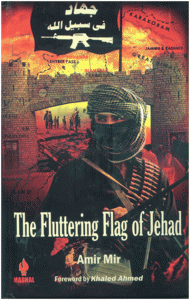An inside track on the state of jehad in Pakistan
THE FLUTTERING FLAG OF JEHAD
AUTHORED BY AMIR MIR, PUBLISHED BY MASHAAL BOOKS, PAKISTAN
ASIN: B006PDMMOI
Amir Mir is among Pakistan’s foremost investigative journalists whose insightful writings on terrorism, Islamic militant groups and their links with the country’s military and intelligence establishment have drawn widespread attention. He has developed into an informed commentator on the state of jihad with an uncomfortable inside track with those who are supposed to counter it in Pakistan. Of course jihad has unfortunately become another name for terrorism and those who have taken it out of the roster of the functions of the state and privatised it are to blame for this development.
Now a lot of writers use inside information from the US government to claim that General Pervez Musharraf was sympathetic to the Taliban as they fled from the US attack in 2001. Amir Mir tells us that Corps Commander Peshawar General Safdar Hussain, who signed the peace accord with Baitullah Mehsud at Sararogha near Wana in February 2005, had called him a soldier of peace even as Mehsud’s warriors shouted ‘Death to America’. Major General Faisal Alvi was to accuse some elements in the army high command of being on the side of the Taliban before his assassination in 2008. Baitullah rewarded General Hussain with 200 captured Pakistani troops in August 2007.
Benazir believed Qari Saifullah Akhtar was involved in the attempt on her life in Karachi in October 2007 (p.43). Qari was in prison for trying to kill Musharraf in 2004 and was sprung from there to do the job on Benazir. Musharraf was outraged when he got to know that an ISI protégé had tried to kill him from his safe haven in Dubai after fleeing from Afghanistan in 2001. Qari was special because he was rescued by the spooks after he was found involved in trying to stage a military coup in league with Islamist fanatic Major General Zaheerul Islam Abbasi in 1995. He along with his Harkat Jihad Islami was to become the favourite of the Taliban government.
The place to be mined for leadership talent was Karachi’s Banuri Mosque where the Qari and that other protégé Fazlur Rehman Khalil had received their Deobandi orientation. The third Banuri Mosque protégé of the state was Maulana Masood Azhar, who had formed the Jaish-e Muhammad after being rescued from an Indian jail in 2000 together with Sheikh Ahmed Omar Saeed, the man who later helped kill American journalist Daniel Pearl in Karachi. Qari was recalled from Dubai and kept in custody, and the Lahore High Court did not release him on a habeas corpus petition. But he was released quietly before Benazir arrived in Pakistan in October 2007 (p.45).
After Benazir named him in her posthumous book, Qari was arrested again in March 2008. The reaction came in the shape of a suicide attacks on the Naval War College and the FIA office in Lahore where Qari’s terrorists were being kept for interrogation into the War College attack (p.47). A Karachi terrorist court heard the case against Qari and freed him on bail because the proof with which the prosecution could have proved him guilty had ‘disappeared’. Later he was rearrested but then quietly released by the Home Department because the spooks wanted him freed (p.48).
Fazlur Rehman Khalil is another protected person who lives in Islamabad but governments hardly know what he has been saying to the American authors who visit him. When Islamabad got into trouble with its own clerics in Lal Masjid, it was Khalil who was taken out and made to negotiate with them (p.109). He is the sort of person who can some day get Pakistan into trouble after which Islamabad will have to say he has mysteriously left the country and cannot be produced. He is Osama bin Laden’s man and his Harkatul Mujahideen was prominent among the jihadi organisations in Kashmir and ran training camps for warriors in Dhamial just outside Rawalpindi, at least that is what an American suspect Hamid Hayat told the FBI after visiting it (p.108).
The book also reports that the hijacking — done by Masood Azhar’s brother Abdul Rauf and brother-in-law Yusuf Azhar — of an Indian airliner that led to the release of Omar Sheikh and Masood Azhar from an Indian jail was linked to the ISI because its Quetta-based officers talked to the hijackers on the wireless set at Kandahar (p.128). Masood Azhar then went on to attack the Parliament in New Delhi in 2001, a month after 9/11. ISI chief Javed Ashraf Qazi on March 6, 2004 admitted that Jaish was involved in the New Delhi parliament assault (p.134). Later Jaish militants were to be housed in Lal Masjid during its siege by state troops in 2007 (p.141).
The writer concludes that the flag of militant Islam keeps fluttering high more alarmingly even than usual, with extremist jehadis literally marching on the state.
